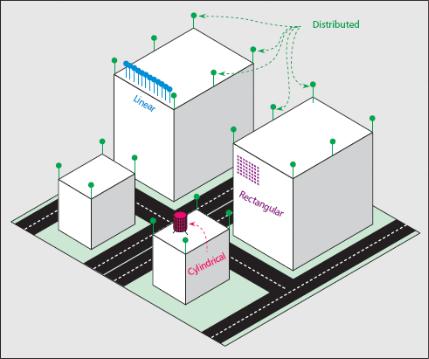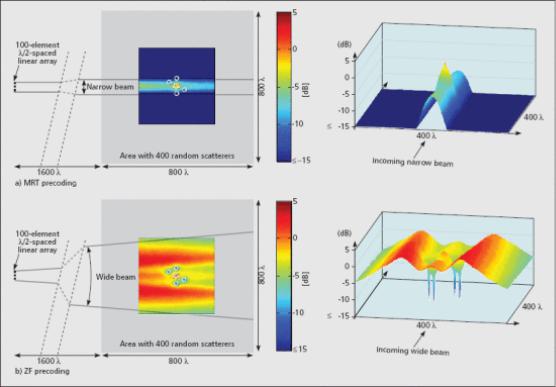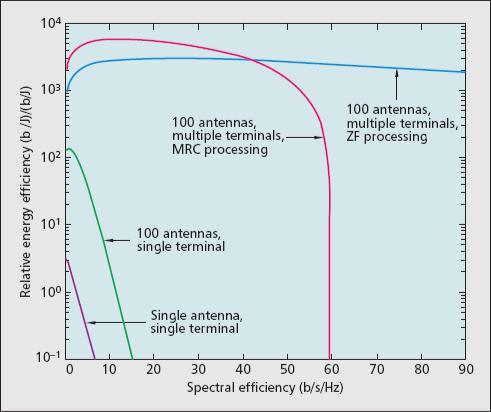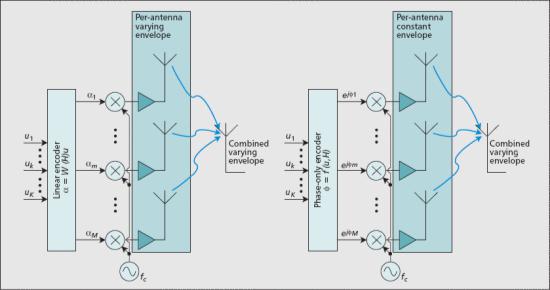
Going Large_Massive MIMO
.pdf
Going Large: Massive MIMO
Massive multiple-input multiple-output (MIMO) is an emerging technology that scales up MIMO by possibly orders of magnitude compared to the current state of the art. In this article, we follow up on our earlier exposition, with a focus on the developments in the last three years; most particularly, energy efficiency, exploitation of excess degrees of freedom, time-division duplex (TDD) calibration, techniques to combat pilot contamination, and entirely new channel measurements.
With massive MIMO, we think of systems that use antenna arrays with a few hundred antennas simultaneously serving many tens of terminals in the same time-frequency resource. The basic premise behind massive MIMO is to reap all the benefits of conventional MIMO, but on a much greater scale. Overall, massive MIMO is an enabler for the development of future broadband (fixed and mobile) networks, which will be energy-efficient, secure, and robust, and will use the spectrum efficiently. As such, it is an enabler for the future digital society infrastructure that will connect the Internet of people and Internet of Things with clouds and other network infrastructure. Many different configurations and deployment scenarios for the actual antenna arrays used by a massive MIMO system can be envisioned (Fig. 1). Each antenna unit would be small and active, preferably fed via an optical or electric digital bus.
Figure 1.
Some possible antenna configurations and deployment scenarios for a massive MIMO base station.
Massive MIMO relies on spatial multiplexing, which in turn relies on the base station having good enough channel knowledge, on both the uplink and the downlink. On the uplink, this is easy to accomplish by having the terminals send pilots, based on which the base station estimates the channel responses to each of the terminals. The downlink is more difficult. In conventional MIMO systems such as the Long Term Evolution (LTE) standard, the base station sends out pilot waveforms, based on which the terminals estimate the channel responses, quantize the thus obtained estimates, and feed them back to the base station. This will not be feasible in massive MIMO systems, at least not when operating in a high-mobility environment, for two reasons. First, optimal downlink pilots should be mutually orthogonal between the antennas. This means that the amount of time-frequency resources needed for downlink pilots scales with the number of antennas, so a massive MIMO system would require up to 100 times more such resources than a conventional system. Second, the number of channel responses each terminal must estimate is also proportional to the number of base station antennas. Hence, the uplink resources needed to inform the base
1

station of the channel responses would be up to 100 times larger than in conventional systems. Generally, the solution is to operate in TDD mode, and rely on reciprocity between the uplink and down-link channels, although frequency-division duplext (FDD) operation may be possible in certain cases.
While the concepts of massive MIMO have been mostly theoretical so far, stimulating much research particularly in random matrix theory and related mathematics, basic testbeds are becoming available, and initial channel measurements have been performed.
The Potential of Massive MIMO
Massive MIMO technology relies on phase-coherent but computationally very simple processing of signals from all the antennas at the base station. Some specific benefits of a massive MU-MIMO system are:
Massive MIMO can increase the capacity 10 times or more and simultaneously improve the radiated energy efficiency on the order of 100 times. The capacity increase results from the aggressive spatial multiplexing used in massive MIMO. The fundamental principle that makes the dramatic increase in energy efficiency possible is that with a large number of antennas, energy can be focused with extreme sharpness into small regions in space (Fig. 2). The underlying physics is coherent superposition of wavefronts. By appropriately shaping the signals sent out by the antennas, the base station can make sure that all wavefronts collectively emitted by all antennas add up constructively at the locations of the intended terminals, but destructively (randomly) almost everywhere else. Interference between terminals can be suppressed even further by using, for example, zero-forcing (ZF). This, however, may come at the cost of more transmitted power, as illustrated in Fig. 2.
Figure 2.
Relative field strength around a target terminal in a scattering environment of size 800λ×800λ when the base station is placed 1600λ to the left. Average field strengths are calculated over 10, 000 random placements of 400 scatterers when two different linear precoders are used: a) MRT precoders; b) ZF precoders. Left: pseudo-
2

color plots of average field strengths, with target user positions at the center ( ) and four other users nearby (). Right: average field strengths as surface plots, allowing an alternate view of the spatial focusing.
More quantitatively, Fig. 3 depicts the fundamental trade-off between energy efficiency in terms of the total number of bits (sum rate) transmitted per Joule per terminal receiving service of energy spent, and spectral efficiency in terms of total number of bits (sum rate) transmitted per unit of radio spectrum consumed. The figure illustrates the relation for the uplink, from the terminals to the base station (the down-link performance is similar). The figure shows the trade-off for three cases:
A reference system with one single antenna serving a single terminal (purple)
A system with 100 antennas serving a single terminal using conventional beamforming (green)
A massive MIMO system with 100 antennas simultaneously serving multiple (about 40 here) terminals (red, using maximum ratio combining, and blue, using ZF).
Figure 3.
Half the power — twice the force : Improving uplink spectral efficiency 10 times and simultaneously increasing the radiated power efficiency 100 times with massive MIMO technology, using extremely simple signal processing, taking into account the energy and bandwidth costs of obtaining channel state information.
The attractiveness of maximum ratio combining (MRC) compared with ZF is not only its computational simplicity — multiplication of the received signals by the conjugate channel responses — but also that it can be performed in a distributed fashion, independently at each antenna unit. While ZF also works fairly well for a conventional or moderately sized MIMO system, MRC generally does not. The reason that MRC works so well for massive MIMO is that the channel responses associated with different terminals tend to be nearly orthogonal when the number of base station antennas is large.
The prediction in Fig. 3 is based on an information-theoretic analysis that takes into account intracell interference, as well as the bandwidth and energy cost of using pilots to acquire channel state information in a high-mobility environment. With the MRC receiver, we operate in the nearly noise-limited regime of information theory. This means providing each terminal with a rate of about
3
1 b/cornplex dimension (1 b/s/Hz). In a massive MIMO system, when using MRC and operating in the “green” regime (i.e., scaling down the power as much as possible without seriously affecting the overall spectral efficiency), multiuser interference and effects from hardware imperfections tend to be overwhelmed by the thermal noise. The reason that the overall spectral efficiency still can be 10 times higher than in conventional MIMO is that many tens of terminals are served simultaneously, in the same time-frequency resource. When operating in the 1 b/dimension/terminal regime, there is also some evidence that intersymbol interference can be treated as additional thermal noise [7], hence offering a way of disposing with orthogonal frequency-division multiplexing (OFDM) as a means of combatting intersymbol interference.
Massive MIMO can be built with inexpensive, low-power components.
Massive MIMO is a game changing technology with regard to theory, systems, and implementation. With massive MIMO, expensive ultra-linear 50 W amplifiers used in conventional systems are replaced by hundreds of low-cost amplifiers with output power in the milli-Watt range. The contrast to classical array designs, which use few antennas fed from high-power amplifiers, is significant. Several expensive and bulky items, such as large coaxial cables, can be eliminated altogether. (The typical coaxial cables used for tower-mounted base stations today are more than 4 cm in diameter!)
Massive MIMO reduces the constraints on accuracy and linearity of each individual amplifier and RF chain. All that matters is their combined action. In a way, massive MIMO relies on the law of large numbers to make sure that noise, fading, and hardware imperfections average out when signals from a large number of antennas are combined in the air. The same property that makes massive MIMO resilient against fading also makes the technology extremely robust to failure of one or a few of the antenna unit(s).
The drastically improved energy efficiency enables massive MIMO systems to operate with a total output RF power two orders of magnitude less than with current technology. This mat-ters, because the energy consumption of cellular base stations is a growing concern worldwide. In addition, base stations that consume many orders of magnitude less power could be powered by wind or solar, and hence easily deployed where no electricity grid is available. As a bonus, the total emitted power can be dramatically cut, and therefore the base station will generate substantially less electromagnetic interference. This is important due to the increased concerns regarding electromagnetic exposure.
Massive MIMO enables a significant reduction of latency on the air interface.
The performance of wireless communications systems is normally limited by fading. Fading can render the received signal strength very small at certain times. This happens when the signal sent from a base station travels through multiple paths before it reaches the terminal, and the waves resulting from these multiple paths interfere destructively. It is this fading that makes it hard to build low-latency wireless links. If the terminal is trapped in a fading dip, it has to wait until the propagation channel has sufficiently changed until any data can be received. Massive MIMO relies on the law of large numbers and beamforming in order to avoid fading dips, so fading no longer limits latency.
Massive MIMO simplifies the multiple access layer.
Due to the law of large numbers, the channel hardens so that frequency domain scheduling no longer pays off. With OFDM, each subcarrier in a massive MIMO system will have substantially the same channel gain. Each terminal can be given the whole bandwidth, which renders most of the physical layer control signaling redundant.
4

Massive MIMO increases the robustness against both unintended man-made interference and intentional jamming.
Intentional jamming of civilian wireless systems is a growing concern and a serious cyber-security threat that seems to be little known to the public. Simple jammers can be bought off the Internet for a few hundred dollars, and equipment that used to be military-grade can be put together using off- the-shelf software radio-based platforms for a few thousand dollars. Numerous recent incidents, especially in public safety applications, illustrate the magnitude of the problem. During the EU summit in Gothen-burg, Sweden, in 2001, demonstrators used a jammer located in a nearby apartment, and during critical phases of riots, the chief commander could not reach any of the 700 police officers engaged.
Due to the scarcity of bandwidth, spreading information over frequency just is not feasible, so the only way of improving robustness of wireless communications is to use multiple antennas. Massive MIMO offers many excess degrees of freedom that can be used to cancel signals from intentional jammers. If massive MIMO is implemented using uplink pilots for channel estimation, smart jammers could cause harmful interference with modest transmission power. However, more clever implementations using joint channel estimation and decoding should be able to substantially diminish that problem.
Figure 4.
Conventional MIMO beamforming contrasted with per-antenna constant envelope transmission in massive MIMO. Left: conventional beamforming, where the signal emitted by each antenna has a large dynamic range. Right: per-antenna constant envelope transmission, where each antenna sends out a signal with a constant envelope.
Massive MIMO: A Gold Mine of Research Problems
While massive MIMO renders many traditional problems in communication theory less relevant, it uncovers entirely new problems that need research.
Fast and distributed coherent signal processing
Massive MIMO arrays generate vast amounts of baseband data that must be processed in real time. This processing will have to be simple, and simple means linear or nearly linear. Fundamentally, this is good in many cases (Fig. 3). Much research needs be invested in the design of optimized algorithms and their implementation. On the downlink, there is enormous potential for ingenious precoding schemes. Some examples of recent work in this direction include.
5
The Challenge of Low-Cost Hardware
Building hundreds of RF chains, up/down converters, analog-to-digital (A/D)-digital-to-analog (D/A) converters, and so forth, will require economy of scale in manufacturing comparable to what we have seen for mobile handsets.
Hardware Impairments
Massive MIMO relies on the law of large numbers to average out noise, fading and to some extent, interference. In reality, massive MIMO must be built with low-cost components. This is likely to mean that hardware imperfections are larger: in particular, phase noise and I/Q imbalance. Lowcost and power-efficient A/D converters yield higher levels of quantization noise. Power amplifiers with very relaxed linearity requirements will necessitate the use of per-antenna low peak-to-average signaling, which, as already noted, is feasible with a large excess of transmitter antennas. With lowcost phase locked loops or even free-running oscillators at each antenna, phase noise may become a limiting factor. However, what ultimately matters is how much the phase will drift between the point in time when a pilot symbol is received and the point in time when a data symbol is received at each antenna. There is great potential to get around the phase noise problem by design of smart transmission physical layer schemes and receiver algorithms.
Internal Power Consumption
Massive MIMO offers the potential to reduce the radiated power 1000 times and at the same time drastically scale up data rates. However, in practice, the total power consumed must be considered, including the cost of baseband signal processing. Much research must be invested in highly parallel, perhaps dedicated, hardware for the baseband signal processing.
Channel Characterization
There are additional properties of the channel to consider when using massive MIMO instead of conventional MIMO. To facilitate a realistic performance assessment of massive MIMO systems, it is necessary to have channel models that reflect the true behavior of the radio channel (i.e., the propagation channel including effects of realistic antenna arrangements). It is also important to develop more sophisticated analytical channel models. Such models need not necessarily be correct in every fine detail, but they must capture the essential behavior of the channel. For example, in conventional MIMO the Kronecker model is widely used to model channel correlation. This model is not an exact representation of reality, but provides a useful model for certain types of analysis despite its limitations. A similar way of thinking could probably be adopted for massive MIMO channel modeling.
New Deployment Scenarios
It is considered extraordinarily difficult to introduce a radical new wireless standard. One possibility is to introduce dedicated applications of massive MIMO technology that do not require backward compatibility. For example, as discussed earlier, in rural areas, a billboard-sized array could provide 20 Mb/s service to each of 1000 homes using special equipment that would be used solely for this application. Alternatively, a massive array could provide the backhaul for base stations that serve small cells in a densely populated area. Thus, rather than thinking of massive MIMO as a competitor to LTE, it can be an enabler for something that was just never before considered possible with wireless technology.
System Studies and Relation to Small-Cell and Heterogeneous Network Solutions
The driving motivation of massive MIMO is to simultaneously and drastically increase data rates and overall energy efficiency. Other potential ways of reaching this goal are network densification by the deployment of small cells, resulting in a heterogeneous architecture, or coordination of the transmission of multiple individual base stations. From a purely fundamental perspective, the ultimately limiting factor of the performance of any wireless network appears to be the availability of good enough channel state information (CSI) to facilitate phase-coherent processing at multiple antennas or multiple access points. Considering factors like mobility, Doppler shifts, phase noise, and clock synchronization, acquiring high-quality CSI seems to be easier with a collocated massive
6
array than in a system where the antennas are distributed over a large geographical area. But at the same time, a distributed array or small cell solution may offer substantial path loss gains and would also provide some diversity against shadow fading. The deployment costs of a massive MIMO array and a distributed or small cell system are also likely to be very different. Hence, both communication-theoretic and techno-economic studies are needed to conclusively determine which approach is superior. However, it is likely that the winning solution will comprise a combination of all available technologies.
Prototype Development
While massive MIMO is in its infancy, basic prototyping work on various aspects of the technology is going on in different parts of the world. The Argos testbed was developed at Rice University in cooperation with Alcatel-Lucent, and shows the basic feasibility of the massive MIMO concept using 64 coherently operating antennas. In particular, the testbed shows that TDD operation relying on channel reciprocity is possible. One of the virtues of the Argos testbed in particular is that it is entirely modular and scalable, and built around commercially available hardware (the WARP platform). Other test systems around the world have also demonstrated the basic feasibility of scaling up the number of antennas. The Ngara testbed in Australia uses a 32-element base station array to serve up to 18 users simultaneously with true spatial multiplexing. Continued testbed development is highly desired to both prove the massive MIMO concept with even larger numbers of antennas and discover potentially new issues that urgently need research.
Conclusions and Outlook
In this article we have highlighted the large potential of massive MIMO systems as a key enabling technology for future beyond fourth generation (4G) cellular systems. The technology offers huge advantages in terms of energy efficiency, spectral efficiency, robustness, and reliability. It allows for the use of low-cost hardware at both the base station and the mobile unit side. At the base station the use of expensive and powerful, but power-inefficient, hardware is replaced by massive use of parallel low-cost low-power units that operate coherently together. There are still challenges ahead to realize the full potential of the technology, for example, computational complexity, realization of distributed processing algorithms, and synchronization of the antenna units. This gives researchers in both academia and industry a gold mine of entirely new research problems to tackle.
There are still challenges ahead to realize the full potential of the technology, for example, when it comes to computational complexity, realization of distributed processing algorithms, and synchronization of the antenna units.
7
